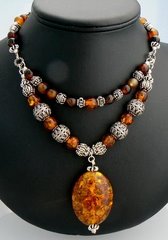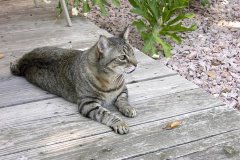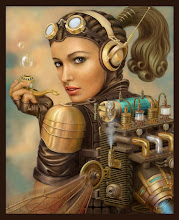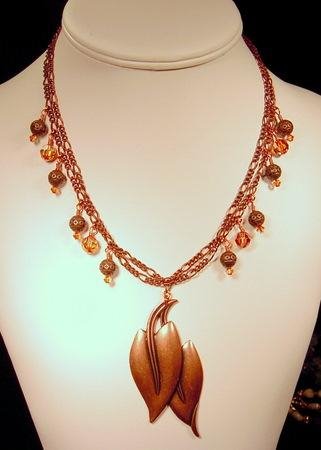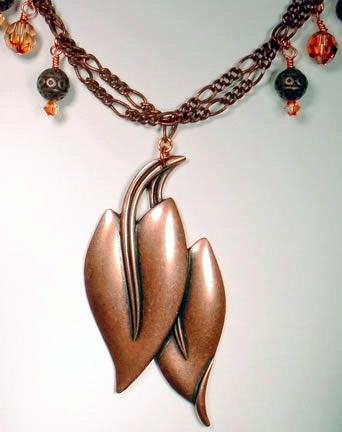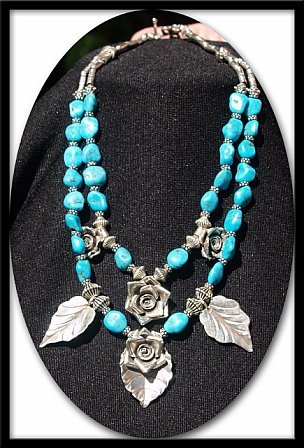Etching a design on metal sheet, such as copper or brass, is a beautiful way to add your own very personal touch to a piece of jewelry or artwork.
After working with copper and brass forging and fold-forming, I am ready to try my hand at etching.
There are myriad websites with information on the various ways to etch a design on copper and brass sheet metal. I spent hours reviewing more websites than I care to count, and discovered there are a number of different ways to achieve good etching results.
I have chosen to use the Radio Shack PCB Etching Solution (ferric chloride), along with various types of resists. The mordant, or etching solution as it's commonly referred to, was an easy choice for me. Ferric chloride is inexpensive (the bottle I purchased at Radio Shack was ~$10) and relatively safe to work with. It's also reusable, which makes it even more cost effective.
***SAFETY FIRST!!!***
If you decide to try etching, always use proper safety protection. Ferric chloride can be irritating to the skin and eyes, and stains EVERYTHING!
Use in a well ventilated area and wear old clothing you don't mind getting stained.
If you decide to try etching, always use proper safety protection. Ferric chloride can be irritating to the skin and eyes, and stains EVERYTHING!
Use in a well ventilated area and wear old clothing you don't mind getting stained.
ALWAYS WEAR EYE PROTECTION, RUBBER OR LATEX GLOVES, AND AN APRON!
The one thing that I never found a definitive answer to was what is the best resist to use with ferric chloride. Many websites refer to using "paint pens"; a pen with permanent, water resistant, non-ink fluid. I have one on hand that I purchased for a glass painting project, so I'll see how it works compared to nail polish and acrylic paint.
Thus begins the "experiment" today, trying various items I have on hand to see which one, if any, will be sufficient to use as a resist.
EXPERIMENT 1:
I found some copper plumbing end caps and a few brass discs to etch. Here is how I began:
CLEANING - The metal needs to be CLEAN before applying any resist. Scrub the metal with a scouring pad, steel wool, or a Scotch Brite pad. I happened to have an S.O.S. pad on hand, so that is what I cleaned the metal pieces with.
TYPES OF RESIST - A few of the sources I read mentioned using acrylic paint and/or nail polish as resists. I have both of those, so I applied a design in nail polish on a few of the copper pieces, and used some acrylic craft paint on the brass discs. I also used a glass paint pen (Pebeo black porcelain paint pen) which is designed to write on glass.
After applying the various resists to the metal pieces, I placed them all on a cardboard sheet and popped them into the toaster over for 10 minutes at 250 degrees. I use a toaster oven to set paints on other metal items, so I felt that this may help to seal the resists and make a better bond.
When the pieces are out of the oven and cooled, I applied a layer of acrylic craft paint to the backs of the discs and the sides of the copper pipe ends. This should protect these areas from etching. Many of the references I've read stated that the acrylic paint works well for many people as a resist to protect the areas that are not being etched. Other suggestions were painters' tape and clear packaging tape.
After the paint dried, I selected a plastic container large enough to use for the etch bath.
Here are the first two processes I used:
For the brass discs, I used clear packing tape to stick to the painted (back) sides of the discs. I suspended the tape ( with the discs facing downward) by sticking the free ends to the sides of the second plastic container. This allowed the discs to be completely submersed in the etching bath while allowing me to be able to agitate the solution and easily check to see the etching progress.
For the copper pipe ends, I covered the sides of each copper piece with acrylic paint and used nail polish for the etch design. After the polish and paint dried completely, I stuck the pipe ends, open side down, onto thick, cushioned double sided tape and then pressed the tape directly onto the bottom of the plastic container. I poured enough of the etching solution into the container to cover the pipe ends.
30 minutes later: I removed all the items from their etching baths. The brass discs were etched very nicely, but the copper appeared to have not etched at all.
I cleaned off the acrylic paint from the sides of the copper pipe ends and noticed that some etching had taken place, apparently through the acrylic paint. I'm guessing that I needed to apply a second coat.
I repainted the copper pieces with 2 layers of acrylic paint and let them dry and then poured the ferric chloride back into the container. This time I gave it an hour before checking the progress.
THE RESULTS:
Both the copper and the brass pieces etched beautifully using the ferric chloride. The nail polish worked great, but if you want etch a design that requires a finer line, the paint pen is what you want to use.
The brass etched must faster than the copper. I had to leave the copper pieces in the etchant for about 90 minutes, versus only 30 minutes for the brass.
Here are a few of the experiments I'm going to try next:
STENCILS - The use of stencils is a tried and true practice, especially for PCB etching. You can obtain incredibly fine details using phototransfer stencils. But what I would like to find out is if I can use plastic art stencils adhered to the metal sheet with stencil adhesive. I have not found any reference to this being tried. (It may be out there somewhere, but I never came across it.)
I think that you could get a clear design onto the metal using the stencil with adhesive. I also found that I had purchased some stencils for use with glass sand etching. These stencils have the adhesive backs that I was interested in trying. I don't see why these wouldn't work with this project, but we'll have to see :)
My idea is to adhere the stencil to the metal sheet, apply the resist and let dry completely. Then peel the stencil off before submersing the metal in the etching solution. My hope is that the stencil will provide a clean, detailed design that would be easy to duplicate.
REVERSE ETCH - This may not be the correct term for what I intend to do, but here is the plan:
Coat a copper or brass object with acrylic paint. ( I choose this resist because it is easily scraped off.) Once the paint is dry, I will scratch a design through the paint. This should result in a design that is etched INTO the metal rather than being RAISED on the metal.
Check back soon for the results of the next etching experiment!
